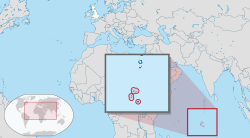British Indian Ocean Territory | |
|---|---|
| Motto: | |
| Anthem: "God Save the King" | |
 | |
| Sovereign state | |
| Capital and settlement | Administered from London Local government from Camp Thunder Cove 7°18′S 72°24′E / 7.300°S 72.400°E |
| Official languages | English |
| Ethnic groups (2001) |
|
| Government | Directly administered dependency under a constitutional monarchy |
• Monarch | Charles III |
| Nishi Dholakia (acting)[1] | |
• Administrator | Bob Fairweather[1] |
| Government of the United Kingdom | |
• Minister | Stephen Doughty |
| Area | |
• Total | 54,000 km2 (21,000 sq mi) |
• Water (%) | 99.89 |
• Land | 60 km2 (23 sq mi) |
| Population | |
• Non-permanent 2018 estimate | |
• Permanent | 0 |
• Density | 50.0/km2 (129.5/sq mi) |
| Currency |
|
| Time zone | UTC+06:00 |
| Mains electricity | 230 Volt, 50 Hertz |
| Driving side | right |
| Calling code | +246 |
| UK postcode | BBND 1ZZ |
| ISO 3166 code | IO |
| Internet TLD | .io |
| Website | biot.gov.io |
The British Indian Ocean Territory (BIOT) is an Overseas Territory of the United Kingdom situated in the Indian Ocean, halfway between Tanzania and Indonesia. The territory comprises the seven atolls of the Chagos Archipelago with over 1,000 individual islands, many very small, amounting to a total land area of 60 square kilometres (23 square miles).[3] The largest and most southerly island is Diego Garcia, 27 square kilometres (10 square miles), the site of a Joint Military Facility of the United Kingdom and the United States.[6] Official administration is remote from London,[7][8] though the local capital is often regarded as being on Diego Garcia.[9]
The only inhabitants are British and United States military personnel, and associated contractors, who collectively number around 3,000 (2018 figures).[3] The forced removal of Chagossians from the Chagos Archipelago occurred between 1968 and 1973. The Chagossians, then numbering about 2,000 people, were expelled by the British government to Mauritius and Seychelles, even from the outlying islands far away from the military base on Diego Garcia. Today, the Chagossians are still trying to return, but the British government has repeatedly denied them the right of return despite calls from numerous human rights organisations to let them.[10][11] The islands are off-limits to Chagossians, tourists, and the media.
Since the 1980s, the Government of Mauritius sought to gain control over the Chagos Archipelago, which was separated from the then Crown Colony of Mauritius by the UK in 1965 to form the British Indian Ocean Territory. A February 2019 advisory opinion of the International Court of Justice called for the islands to be given to Mauritius. Afterward, both the United Nations General Assembly and the International Tribunal for the Law of the Sea reached similar decisions. Negotiations between the UK and Mauritius began in November 2022, and culminated in an October 2024 agreement that the UK would eventually cede the territory to Mauritius while retaining the joint US-UK military base on Diego Garcia.[12]
- ^ a b c "Governance". British Indian Ocean Territory. Retrieved 21 October 2024.
- ^ "FCO country profile – British Indian Ocean Territory". Archived from the original on 10 June 2010. Retrieved 27 March 2010.
- ^ a b c "British Indian Ocean Territory". World Factbook. Central Intelligence Agency. 27 March 2013. Retrieved 16 June 2020.
- ^ "British Indian Ocean Territory Currency". GreenwichMeantime.com. Archived from the original on 22 July 2016. Retrieved 5 April 2013.
- ^ "Launch of first commemorative British Indian Ocean Territory coin". coinnews.net. Pobjoy Mint Ltd. 17 May 2009. Retrieved 4 April 2014.
- ^ Chirayu Thakkar (12 July 2021). "Overcoming the Diego Garcia stalemate". WarOnTheRocks.com.
- ^ "British Indian Ocean Territory – GOV.UK". www.gov.uk. Retrieved 3 September 2023.
- ^ "British Indian Ocean Territory". Commonwealth Chamber of Commerce. Retrieved 3 September 2023.
- ^ "British Indian Ocean Territory Definition & Meaning". Dictionary.com. Retrieved 3 September 2023.
- ^ "Mauritius profile". BBC News. 2011. Retrieved 4 April 2012.
- ^ "Historical background – what happened to the Chagos Archipelago?". chagosinternational.org. Archived from the original on 8 February 2013. Retrieved 4 April 2012.
- ^ Cite error: The named reference
UKGovStatement20241003was invoked but never defined (see the help page).

